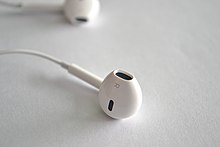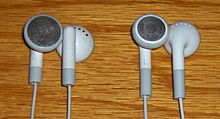Apple headphones
 | |
| Developer | Apple Inc. |
|---|---|
| Type | Earphones |
| Release date | Fall 2012 |
| Mass | 11.9 g EarPods (Lightning) 12.6 g EarPods (3.5 mm) |


Apple EarPods are white in-ear headphones included with music players and smartphones designed and marketed by Apple Inc. They are designed to fit the ear while retaining a new design pushed by Apple alongside the iPod and iPod Touch products, with which they were sold together. They are the standard headphones provided with Apple iPhone purchases.
History
Classic round design
The classic earbuds shipped with all iPods before the fifth generation of both the iPod touch and iPod nano, and the iPhone 5 (which are shipped with the newer Apple EarPods made in Taiwan rather than Japan).
iPod Earphones

- The first generation earbuds were packaged with the original iPod, on October 23, 2001.
- They are bundled with two pairs of foam covers.[1]
- The second generation earphones added a plastic slider to allow the user to limit the gap between the wires.
- The third generation is the successor of the original-style earbuds, bundled with the fifth generation iPod video, the second generation iPod nano.[1] and their successors.
- The earbuds were redesigned with a slightly longer strain relief, a slightly smaller speaker grill, and the left/right marking being moved from the outside to the inside.
iPhone Stereo Headset

Model number MA814LL/A. Bundled with the original iPhone and iPhone 3G, they feature a control capsule in-line with the right earbud's wire; they house a microphone and a single button, actuated by squeezing the unit, which (if supported by the device and its software) can activate features such as controlling calls, presentations, or music and video playback, launching Siri, or taking pictures with Camera application. There have been many reports of moisture problems with the remote/mic earbuds.[2]
Apple Earphones with Remote and Mic
Shipped with the iPhone 3GS, iPhone 4, iPhone 4S, the third-generation iPod touch, and independently.[3] They expand on the iPhone Stereo Headset by adding two other buttons dedicated to volume control.
Earbuds with remote
Variant of the Earphones with Remote and Mic without a microphone. They shipped only with the third-generation iPod shuffle.
Apple In-Ear Headphones
Apple In-Ear Headphones[4][5] (introduced on September 9, 2008, revised on September 12, 2012) are only sold independently. Like the regular earbuds they have a remote control and microphone built-in. They are made available as the high-end earbud offering with dual drivers, advertised as "engineered for superior acoustic accuracy, balance, and clarity".[4] The remote and protective case was redesigned on September 12, 2012, with the remote now matching that of the EarPods and the case subsequently modified with elements of the EarPods case while retaining the triangular shape.
Apple EarPods

Apple EarPods (renamed "EarPods with 3.5mm Headphone plug")[6] (introduced on September 12, 2012) first shipped with the iPhone 5 and feature a remote control and microphone. They also ship with the iPod Touch (5th generation) (without remote and mic) and the iPod Nano (7th generation) (without remote and mic). They are also sold independently.[6] The EarPods shipped with the iPhone 5 and later, along with those individually sold, come with a carrying case, whilst the iPod Touch (5th generation), iPod Touch (6th generation) and iPod Nano (7th generation) only have basic biodegradable packaging, due to their lack of a remote and mic. A microphone icon was added on the previously unmarked back side of the control capsule, on EarPods models actually having a microphone.[7] They are compatible with iPhone 3GS - iPhone 6S, iPod Touch (2nd generation) and onwards and all models of the iPad and iPad mini. They require iOS 2.2 and onwards for iOS devices but are not compatible with the original iPhone, iPhone 3G, or iPod Touch (1st generation) due to sound problems. They are also compatible with most Android devices and computers.
EarPods with Lightning Connector ship with the iPhone 7 and later models and work with all devices that have a Lightning connector and support iOS 10 or later. Until September 12, 2018, iPhone models from the iPhone 7 to the iPhone X also shipped with a Lightning-to-3.5mm headphone jack adapter, enabling customers to connect 3.5mm headphones to a Lightning port. While it is no longer included with any iPhone models, this adapter remains available for purchase from Apple and third-party retailers.
AirPods

AirPods were introduced at the "See you on the 7th" event in September 2016 and initially supposed to launch before the end of October 2016.[8] After being delayed from its original launch date,[9] AirPods became available for online purchase on December 13, 2016.[10] The AirPods are wireless earbud-style headphones with microphone, dual accelerometers, IR sensors used to pause the music if they are not in a user's ears, and motion touch sensors that are used to activate Siri. With the absence of an audio jack in the iPhone 7, a wireless connection is one of only two remaining means to connect earphones to the device, the other being digital audio through the Lightning connector. They are advertised to have a battery life of five hours, and come with a charging case that gives them a total of 24 hours of battery life. The case is charged via an included Lightning to USB cable. AirPods are compatible with iPhone, iPad, Apple Watch, Macs, the 6th generation iPod Touch, and the 7th generation iPod Nano, but automatic pairing with an iCloud account requires macOS Sierra (or a higher version of the macOS), iOS 10 and watchOS. They are also compatible with devices on other platforms that support Bluetooth, but the setup process is comparatively complicated and limits the AirPods' functionality.[11][12]
See also
References
- ^ a b "Apple iPod shuffle 2G Review". IT Pro. November 4, 2006. Retrieved January 6, 2018.
- ^ Apple Earphones with Remote and Mic Lowest Ratings Archived April 25, 2009, at the Wayback Machine
- ^ "Compatibility of Apple wired headset models with iPhone, iPad, and iPod models". Apple Support. September 9, 2016.
- ^ a b Apple In-Ear Headphones with Remote and Mic, Apple Store
- ^ Apple In Ear Headphones with Remote and Mic, Amazon.com
- ^ a b "Apple EarPods with Remote and Mic". Apple. Retrieved January 19, 2016.
- ^ Are Your Apple Headphones Real or Fake?
- ^ "Apple - Press Info - Apple Reinvents the Wireless Headphone with AirPods". www.apple.com. Retrieved October 3, 2016.
- ^ Mark Sullivan (December 13, 2016). "Like Apple's AirPods, Doppler's Wireless Earbuds Got Delayed. Here's Why". Fast Company. Retrieved December 14, 2016.
- ^ Adi Robertson (December 13, 2016). "Apple's wireless AirPods are now on sale". The Verge. Retrieved December 14, 2016.
- ^ Ashley Carman (September 7, 2016). "Apple AirPods are truly wireless earbuds". The Verge.
- ^ Ina Fried (September 7, 2016). "Apple's AirPods do use Bluetooth and they don't require an iPhone 7". Recode.
